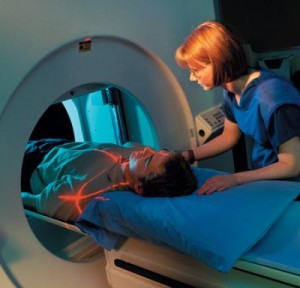Mesothelioma patients who undergo a procedure called talc pleurodesis (TP) for excess lung fluid may be harder to monitor with FDG-PET/CT scans afterward.
 Talc pleurodesis is a procedure used to manage pleura effusions, the build-up of fluid around the lungs that causes many of the most uncomfortable symptoms of malignant pleural mesothelioma. As a mesothelioma tumor spreads across the pleural lining, the body often produces fluid in response. As this fluid fills up the pleural cavity between the mesothelial lining and the lungs it can cause pain and make it hard for the mesothelioma patient to breath. Draining the fluid and filling the space with medical-grade talc is one way to deal with the problem.
Talc pleurodesis is a procedure used to manage pleura effusions, the build-up of fluid around the lungs that causes many of the most uncomfortable symptoms of malignant pleural mesothelioma. As a mesothelioma tumor spreads across the pleural lining, the body often produces fluid in response. As this fluid fills up the pleural cavity between the mesothelial lining and the lungs it can cause pain and make it hard for the mesothelioma patient to breath. Draining the fluid and filling the space with medical-grade talc is one way to deal with the problem.
But a new study suggests that talc pleurodesis may interfere with the primary means doctors use to monitor a mesothelioma patient’s disease progression and treatment response. FDG-PET scanning involves injecting the patient with a radioactive tracer and then using PET/CT (positron emission tomography and computerized tomography) to measure how much of the tracer is absorbed by cancer cells. The mesothelioma cells’ ‘uptake’ of tracer can be used to determine how well chemotherapy is working.
But when a team of Italian researchers compared the radiologic and metabolic treatment responses in eight mesothelioma patients who had undergone chemotherapy and talc pleurodesis, they found a problem. Eight patients were evaluated – 7 who had the epithelioid subtype of mesothelioma and 1 who had biphasic. After their TP treatment, they underwent FDG-PET/CT scans twice, once around 14 days and a second time around 125 days. The researchers found that, by increasing the amount of tracer absorbed by cancer cells, TP treatment can make it look as though a patient’s disease is progressing more rapidly than it is.
“TP produces an increased FDG-PET uptake which may interfere with the post-chemotherapy disease evaluation,” observe the researchers. To compensate, they recommend a slightly modified way of interpreting the FDG-PET scan results in these patients.
Sources:
